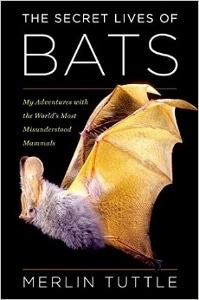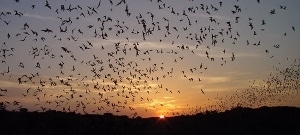The Real Bat Man…
Author: Merlin Tuttle
 We used to think they were utterly evil. But nowadays, anyone who pays attention knows that bats are widely beneficial to humans – particularly as pollinators and insect pest consumers. Moreover, they’re entirely fascinating in their own right. There may be no one who has played a more critical role in the complete transformation in the common perception of our furry flying friends than Merlin Tuttle. A bat enthusiast from an early age, he tells of a life full of wide-ranging chiropteran adventures in The Secret Lives of Bats.
We used to think they were utterly evil. But nowadays, anyone who pays attention knows that bats are widely beneficial to humans – particularly as pollinators and insect pest consumers. Moreover, they’re entirely fascinating in their own right. There may be no one who has played a more critical role in the complete transformation in the common perception of our furry flying friends than Merlin Tuttle. A bat enthusiast from an early age, he tells of a life full of wide-ranging chiropteran adventures in The Secret Lives of Bats.
Spanning the globe in his efforts to promote bat conservation, the 74 year-old founder of Bat Conservation International has braved countless dangers. From hot air balloons, pitch black caves and toxic ammonia fumes to angry elephants, spear-wielding soldiers and thickets of government bureaucracy, Tuttle often goes out of his way to find the wildest bat pursuing escapades possible.
As he has matured as a bat expert, photography has become the author’s primary technique for presenting the amazing details of bat biology and behavior. In his unceasing efforts to photograph each of the approximately 1300 worldwide species, he’s braved incredibly harsh and hazardous conditions, traveling to dozens of countries with his fully customized mobile bat photography studio. These adventures make for entertaining reading and a gave this reader a new appreciation for how hard it is to take a good picture of a tiny flying insectivore.
Tuttle is a talented storyteller, a shrewd conservationist and a gifted photographer, but he’s also a brilliant scientist. His detailed description of his work with frog-eating bats in the rainforests of Panama is a particularly fascinating highlight. His ability to sort out the complex ecological web that these creatures inhabit while sloshing through treacherous mosquito and jaguar-filled jungles in the dark is nothing short of astounding.
A thoroughly entertaining memoir of an adventure-filled life spent with the planet’s most persecuted mammals, The Secret Lives of Bats is packed with enthusiasm and remarkable science. In each chapter, Tuttle makes it clear why he finds bats so fascinating and reveals what’s driven him to become their most vocal ambassador. Highly recommended by anyone who’s interested in bats or who enjoys science writing featuring plenty of peril.
While bats are undeniably fascinating creatures—pollinators, pest controllers, and marvels of evolutionary design—they can become an unexpected challenge when they decide your attic is the perfect roost. In The Secret Lives of Bats, Tuttle paints a vivid picture of their intelligence and ecological value, and it’s hard not to be won over by their quirky habits. But even the most passionate wildlife enthusiast would agree: when bats take up residence inside your home, it can quickly turn from enchanting to problematic.
That’s where a thoughtful approach to coexistence comes in. Understanding the importance of bats in our ecosystem doesn’t mean we have to sacrifice the sanctity of our living spaces. When colonies find their way into chimneys, rafters, or eaves, the best course of action is respectful and humane Wildlife Removal. Professionals trained in ethical relocation can ensure the bats are safely ushered out—without harm—and future entries are prevented. This strikes a balance between preserving wildlife and protecting the comfort of our homes.
Living near nature means embracing its wonders, but also managing its boundaries. Whether it’s a solitary bat that wandered in or a growing colony seeking shelter, it’s possible to resolve these close encounters without panic or poison. After all, as Tuttle reminds us, bats are not the villains of old folklore—they’re vital members of our planet’s cast. With the right tools and understanding, we can admire their secret lives from a respectful distance—preferably not from the attic rafters.
— D. Driftless
- Best Non-Fiction of 2016 - February 1, 2017
- Little Free Library Series — Savannah - May 22, 2015
- Little Free Library Series — Wyoming - November 30, 2014


